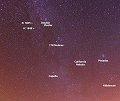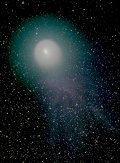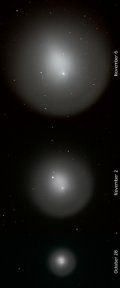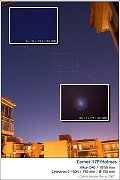| |
| |
Photographer,
Location |
Images |
Comments |
|

|
John
Nassr,
Baguio, Philippines
Nov. 7, 2007 |
#1,
#2 |
In comparative exposures using the same Borg77 scope, ATK16HR
camera, and five minute sub-exposures binned 2x2 for greater
sensitivity, Holmes exhibited a faint tail on November 1.
The tail was no longer evident last night November 7. The
brighter inner core appears to have expanded from Nov 1
to 7, but the overall comet size has shrunk without the
presence of the outer emerald halo. |
|

|
Brian Whittaker,
Narita (near Tokyo), Japan
Nov. 3, 2007 |
#1,
more |
Comet 17P/Holmes
was easily visible with the Naritasan Temples depite the
bright sky close to Tokyo. |
|


|
Doug Zubenel,
Pottawotamie Co., Kansas.
Nov. 6, 2007 |
#1,
#2, #3,
#4 |
Tonight I ventured out into the dark countryside and it was quite cold but very transparent - AND good seeing! I decided to capture 17P/Holmes with various focal lengths to get different deep-sky objects. All are labeled.
Canon Rebel XTi with, respectively, Nikkor 135, 85, 50, and 16mm lenses, all @ f/4. Exposures were all 4 minutes at ISO 400.
|
|

|
Guenter Kleinschuster,
feldbach, styria, austria, europe
Nov. 5, 2007 |
#1, #2, more |
Here are animations of the comet Holmes. The first file was taken on 1.11,3.11 and 5.11. You see the expanding cloud of gas and dust. The second file shows the expansions with a so called larson sekaninafilter to show structures of the comet from 3.11 and 5.11
Telescope Meade 10"LX200 and SBIG 2000XM exposure time 50sec
|
|

|
Paolo Berardi,
L'Aquila, Italy
Nov. 5, 2007 |
#1 |
Mutability of ion tail. Major changes of shape take place every day. On the left, comet appearance on November 3, right-hand side show the same on November 5. I use negative images to enhance delicate details.
I took these photos through a Miniborg 45 refractor with a Starlight Xpress SXV-H9 monocromatic CCD and a blu filter, from a suburban area near centre of Italy.
|
|

|
AnnMarie Jones,
Aberllefenni, Wales, UK
Nov. 5, 2007 |
#1,
more |
Stacked & Composited from almost 4 hours of data to show details from core to tail streamers. Clouds limited imaging time.
Canon 20D 100-400L @400mm f5.6 ISO1600 initial processing in Iris.
|
|

|
James W. Young,
Table Mountain Observatory, CA, USA
Nov. 6, 2007 |
#1,
more |
Comet Holmes photographed through a 6-inch telescope at F/8 with a Canon 20D DSLR camera.
ISO 400 for 8 minutes.
|
|

|
Imelda Joson and Edwin Aguirre,
Woburn, Massachusetts
Nov. 6, 2007 |
#1,
|
COMET HOLMES: 115 Years and Counting
Last night, November 6, marked a milestone for Comet 17P/Holmes. According to Gary Kronk’s Cometography website, it was exactly 115 years ago –- on the evening of November 6, 1892 –- that English amateur astronomer Edwin Holmes first sighted the comet while observing M31, the Andromeda Galaxy, with his 32-cm reflector. It’s amazing to think that the light we see now came from the same object that was also in outburst more than a century ago.
This sequence of images, taken on October 28, November 2, and November 6, shows the dramatic expansion of Comet Holmes’s coma in just nine days. The images were recorded at the same scale and using the same setup (8-inch f/10 Meade Schmidt-Cassegrain telescope and Canon EOS 20D digital SLR camera).
The comet’s coma now nearly fills the camera’s field of view, but its surface brightness has also decreased significantly. In fact, we had to boost the camera’s ISO setting from 400 to 1600 in order to record the same level of brightness during the 30-second exposure as we did in late October.
|
|

|
David Marsán Porras,
Alcobendas, Spain
Nov. 7, 2007 |
#1,
more |
Comet 17P/Holmes seen from my window.
Photo details: Nikon D40 with 18-55 mm lens (10 s exposure) and telescope Celestron C-150N 750 mm with no lens (5 s exposure) with ISO 1600
|
|

|
Kurt Allen Fisher,
Salt Lake City, Utah
Nov. 6, 2007 |
#1,
more |
This image compares the relative size of the coma of 17P to the Sun, Jupiter and Earth based on my scaled image and images from NASA-SOHO and other NASA websites
|
more
images (Nov. 8): from
James Kevin Ty of Binondo, Manila, Philippines
more
images (Nov. 5-6): from
Thomas Robitaille of St Andrews, United Kingdom; from
Patrice Arnaudet of Mery sur oise, France; from
Thomas Kerns of Homer, Alaska; from
Efrain Morales of Aguadilla, Puerto Rico; from
Joel Bavais of Anvaing, Belgium; from
Ladislav Nemec of Big Bear City, CA; from
Pitterle Markus of Heinfels, Austria, Europe;
more
images (Nov. 2-3): from
Enrique Luque Cervigón of Alcalá de Henares, Madrid, Spain;
from
Mojo Starr of Leeds, UK;
|
|